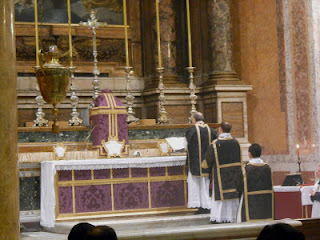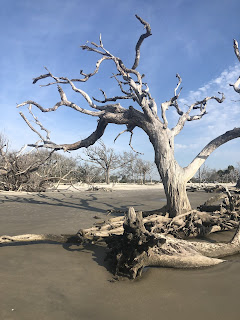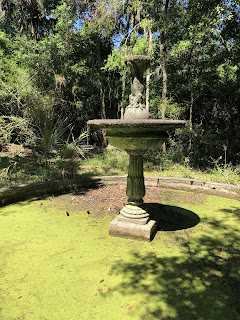In Spanish-heritage countries - and all Catholic rooted countries - November is the Month of the Dead. And it's over for this year, since today, Dec. 1, is the First Sunday of Advent...so we must honor November. It begins with the Feast of All Saints, November 1. Our Halloween, Oct. 31, is of course a shortened version of the full title in English, the "Eve of All Hallows," with the "Hallows" being the Saints. The next day is All Souls' Day, November 2, which is the day for cemetery visits and blessings. In Spanish, this was the Día de los Difuntos (Day of the Dead) or Día de las Animas, meaning the day of the [Holy] Souls. These Souls weren't necessarily Saints (somebody who is already known or proclaimed to be in Heaven), but your Irish grandmother would have referred to them as the Holy Souls, because if they had made it to Purgatory, they were on their way to Heaven. But she might have said the "poor Holy Souls," because Purgatory meant they needed prayers, both at their funerals and afterwards. And it is here that the catafalque comes in. Below we see the All Souls' Day catafalque at St. Trinita in Rome, where the traditional rite is celebrated. This photo is from the Catholic News Live site, where you can find out more about it.
But sometimes the catafalque itself became the focus, because it was used as the representation of the deceased when the body was not present - either because the body had been lost to war, shipwreck or some other disaster, or because the mass was a memorial, celebrated for someone who had already been buried in another place, or on certain dates following the burial, such as 40 days afterwards, a year afterwards, etc.
We have to remember that both Catholic and Protestant funerals, prior to the Second Vatican Council, were very different from what we are accustomed to now. There were no "eulogies" detailing the deceased’s love of beer, embarrassing things he or she had said or done, etc. In other words, no chuckles. It was a very solemn and thought provoking moment, because if it was a funeral with cuerpo presente, meaning that the body of the deceased had been brought into the church, this would be the last time that he or she would be before the altar. When they closed the casket (left open until the Mass began), it would also be the last time that this person’s mortal face would be seen on this earth.
But first things first. In its Greek
original, the word that is the base of catafalque means “platform.” And this indeed was and has
always been its meaning. In Western
funeral and cemetery terms, however, it has a very specific and liturgical
meaning, although now mostly unknown because of changes to Catholic ritual in the 1960s and 1970s decreed by the Second Vatican Council. It was a platform, yes,
but one with a very specific use: to hold the casket or the body of the
deceased during the funeral service and, depending on the circumstances, also
at the graveside for the burial. Often referred to as a bier if it was meant just for holding the casket, it could be very simple or very ornate.
We have to remember that both Catholic and Protestant funerals, prior to the Second Vatican Council, were very different from what we are accustomed to now. There were no "eulogies" detailing the deceased’s love of beer, embarrassing things he or she had said or done, etc. In other words, no chuckles. It was a very solemn and thought provoking moment, because if it was a funeral with cuerpo presente, meaning that the body of the deceased had been brought into the church, this would be the last time that he or she would be before the altar. When they closed the casket (left open until the Mass began), it would also be the last time that this person’s mortal face would be seen on this earth.
So even when the deceased wasn't physically present, the
catafalque remained, dressed as though for a funeral. The above catafalque is in the Cathedral of Guadalajara in Sigüenza, Spain (below). Notice the damage on the tower from the Spanish Civil War.
And now for some spectacular
catafalques. On a recent trip to Spain, I had the great good fortune to have
friends take me to the little town of Atienza (shown below) in the province of Guadalajara
in La Mancha. It’s an area rich in history,
ranging from geologic times to prehistoric man to modern Spain. And there, a
truly remarkable man, don Agustín González Martínez, the 87 year old parish priest, has
built not one but three museums, filled with local finds, ranging from church
art to fossils. In fact, the 2 euro admission fee gets children a free fossil
and a free mineral with their entrance ticket.
Below, we see don Agustín strolling in Atienza with Benito Rodriguez Arbeteta, a well known Spanish art historian who has done considerable research on Atienza.
Don Agustín, in his rambles over the dry and rugged hills, walking or bicycling from parish to parish (at one point, he served 11 small rural parishes in the area), kept his eyes to the ground and picked up all sorts of small fossils and pieces of the local rare minerals.
He put the better pieces in the museums, where they are side by side with one of the most interesting collections of Spanish religious art that I have ever seen. Here below, for example, is a magnificent figure, El Cristo del Perdón, by the Spanish Baroque sculptor, Luis Salvador Carmona. The globe upon which Christ is kneeling and appealing to God for mercy depicts Adam and Eve and several other scenes of sinful humanity.
But back to the catafalque. One
of the things that was present in the church in Atienza was the 16th
century catafalque, which now resides in the church museum. I wasn’t sure if it pre-dated the Council of
Trent, a Catholic council held in 1545-1563 that made some changes to the liturgy,
but it definitely reflects an older, mediaeval sensibility. Once thought to come from Mexico - since the Spanish immediately established workshops in the New World for the production of religious statuary and art, some of which was of such high quality it was then sold in Spain itself - scholars now believe it was produced in Spain. Don Agustín, in his rambles over the dry and rugged hills, walking or bicycling from parish to parish (at one point, he served 11 small rural parishes in the area), kept his eyes to the ground and picked up all sorts of small fossils and pieces of the local rare minerals.
He put the better pieces in the museums, where they are side by side with one of the most interesting collections of Spanish religious art that I have ever seen. Here below, for example, is a magnificent figure, El Cristo del Perdón, by the Spanish Baroque sculptor, Luis Salvador Carmona. The globe upon which Christ is kneeling and appealing to God for mercy depicts Adam and Eve and several other scenes of sinful humanity.
Around the sides are four scenes of death and judgment coming for people in different stations of life. In some there is a speech ribbon, with a figure representing death announcing its presence with a Latin phrase or. A particularly dramatic one has death with the visual depiction of a puff of breath, blowing out the candle of life for the unfortunate man in the painting. However, the words on the stele say, "And the light shone in darkness," and in the ribbon, "and the darkness comprehended it not," from the Gospel of John. So there is hope.
It is on wheels, like the larger ones that such as that waiting in the choir at the Cathedral in
Sigüenza, but it is only about casket-sized in length and about twice as deep. The best source for information on this fascinating piece is Benito Rodriguez Arbeteta's paper, in Spanish only, Nemini Parco [I Spare No Man], available from Academia.edu.
However, while technically all were equal before Death, in the case of royal death commemorations, enormous temporary catafalques were built for memorial masses to acknowledge that this person was a little more equal than others. Below is the catafalque of the Spanish king Felipe IV, who died in 1665.
This was true throughout Europe and sometimes the deceased simply had to be "royalty" in his own field, and in fact some true (but temporary) works of art were created, such as the catafalque of Michelangelo, built by his artist friends. And even atheists such as Voltaire got in on the act, certainly without the aid of religious services, although in his case the catafalque was more of a bier with his body propped on top in ceremonial splendor. He had been buried elsewhere before the French Revolution, and then was "resurrected" afterwards as the intellectual author of the Revolution. His body was then taken out of its burial place at an abbey (allowed only because his brother was the abbot) and sent to Paris. The catafalque was dragged by teams of peasants through the rain from his initial rural burial place and brought to the Pantheon in Paris, where he lies today.
With the decline in belief in the Resurrection, the Last Judgment and Eternity, things have gotten more modest and many people don't even have a funeral service or a burial. If they do have a funeral or burial service, the bier now consists of a folding stand that the funeral director wheels in, sometimes without a casket, but with an urn of cremated remains occupying the top of the stand. And memorial masses no longer have catafalques at all, and in fact they no longer even wear black, except in very traditional churches.
But what’s the connection with Tolomato? It goes back to Second Spanish Period Governor Enrique White, who founded the town of Fernandina as a refuge for the Spanish King Fernando VII, exiled after Napoleon's invasion of Spain. Fernando was autocratic and widely hated, but after the French invasion, he suddenly became "El Deseado," the longed-for one. He did eventually get back into power and only a couple of years later wiped out the Spanish Constitution of 1812, which established a constitutional monarchy and to which there is a contemporary monument on the Plaza in St Augustine. The monument below is a replica in Avilés, Spain, with our friend, former Avilés City Councilman Román Alvarez González, standing in front of it. As for Fernando VII, once he came back, he wound up being (justifiably) hated again. But in any case, at that point, Gov. White thought he was doing the right thing.
Getting back to Tolomato, Gov. Enrique White was the source of all sorts of civic improvements in St Augustine. Sometime before 1811, he requested that a plan be drawn up for the modernization of Tolomato Cemetery, which meant converting this somewhat haphazard space with its unmarked or unidentified burials – all facing east but otherwise helter skelter – into a modern late 18th century cemetery on a grid plan, with marked and numbered spaces, identifiable burials, and of course, different pricing for different areas. We can assume that this had the approval of the parish priest at the time, Fr. Miguel O’Reilly, since there are notations about the cost of quicklime and the wages of the sexton. A section of the map is shown below. It was probably done by George F. Clarke, who platted Fernandina Beach in that same year at the request of Gov. White.
One of the purposes of construction of the Varela Chapel by the Cubans and other followers of Fr. Varela in 1853 was the provision of a funeral chapel for Tolomato. During his time in St Augustine, Fr. Varela had been bothered by the lack of one. The purpose of a funeral chapel was to provide an inside, consecrated place with an altar where funeral masses could be celebrated, since mass was generally not celebrated outside in those days. Below we see a photo of the Varela Chapel, probably taken sometime in the early 20th century.
The accounts of the church say that he was shaved and prepared for his funeral by José Canova, a Canary Islander, and that he was buried under a cairn of stones at Tolomato. The town had planned to get him a more suitable monument, but events overtook St Augustine in this period, resulting in a change of flags only ten years later and the disappearance of the Spanish from Florida. The only place that bears his name is White Street in Fernandina (map shown below, for more information, visit the Amelia Island History Museum). But somewhere in the cemetery, sadly unmarked, lies Governor Enrique White, the Spanish governor who had loved Florida and had planned to put a catafalque in Tolomato.



















































